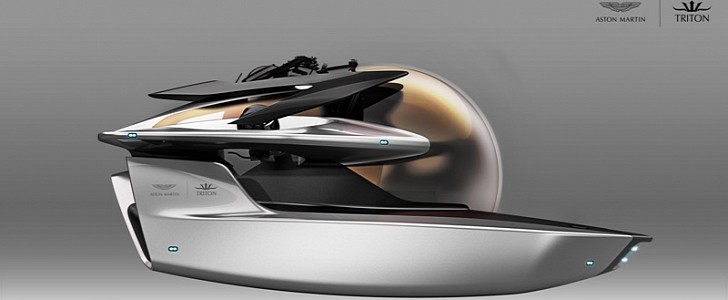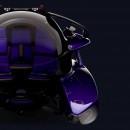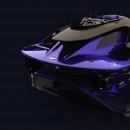Aston Martin took the automotive world by surprise way back in 2017 when they officially announced their collaboration with the Florida-based Triton company to create a luxurious and elegant submersible, naming it Project Neptune.
The design process for this beautiful machine took one more year to reach full completion. The production phase started in May 2018 and developed into an engineering wonder that makes unique statements in body styling, hydrodynamics, and luxurious interior packaging, proudly wearing the signature trident badge of the British supercar manufacturer. Safety, reliability, all-around visibility, and attention to detail like no other are all key elements that set this Aston Martin Triton project apart.
In terms of sheer power, in their own words, its creators set on building a "submersible that dives as an Aston Martin drives." Project Neptune engineers reworked its propulsion system to achieve an impressive four-time better power-to-weight ratio than Triton's flagship model, the 3300/3, ensuring flawless acceleration during underwater journeys, impressive stats that are worth wearing that famous badge.
The agile character of an Aston Martin machine envelops the Project Neptune and is a far departure from Triton's usual neutral and flat approach to diving. In other words, the control system suffered major redesigning highlighting extended pontoons or drag-reducing tapered fixture-free surfaces. Project Neptune has unique underwater abilities to tilt as it drives and carve smooth arches while turning, thus offering a wide range of controls and a more involving piloting experience, same as its supercar counterparts.
The use of the well-proven DNV-GL certified "Low Profile" (LP) Platform developed by the guys at Triton sets the vehicle up to be a reliable and dependable machine. It can offer a novel diving experience for anyone willing to acknowledge their inner curiosity.
The exterior architecture of the Project Neptune incorporates design influences from the Valkyrie hypercar. It would not have been possible without Triton's compact LP platform that enabled the engineering team to curve and sculpt the body with such distinctive proportions, preserving the British brand's DNA in every line and surface.
The spherical pressure hull comes encased in an iridium-coated protective shield that offers excellent clarity of vision and contrast when underwater. Not least, the submersible comes fitted with an exposed carbon fiber wing that successfully complements its looks and gracefully hints at its remarkable performance.
Physically, this ocean gemstone is pretty lightweight and compact. It measures only 13.45 ft (4.10 m) in length, 9.35 ft (2.85 m) in width, and stands just 6.23 ft (1.90 m) tall, tipping the scale at 9,200 lb (4,200 kg).
The unique visual perspective that it displays on the outside continues on when entering its cockpit. The pilot and two other fortunate occupants are enveloped by the exquisite craftsmanship that Aston Martin is known for, which includes fine leather upholstery, contrast hand-stitching, extensive use of carbon fiber, and great attention to every minute detail.
Furthermore, everything is assembled in a non-obstructive manner, offering excellent visibility for admiring the panoramic sight-lines below the surface, up to 1 640 ft (500m) deep into the ocean. This approach promotes the Project Neptune as one of the most luxurious submersibles in the industry, a veritable underwater cruiser that offers all the high-class amenities that its owners are accustomed to. Not least, customization and personalization are endless, the vehicle granting access to the British brand's bespoke service, named Q by Aston Martin.
Of course, this limited-edition endeavor between the two companies has its cost. You are expected to pay around $4 million to experience the underwater world in a classy manner. For the right people, the chance of expanding their personal collection with such a unique vehicle that offers a sense of freedom otherwise unattainable is priceless.
In terms of sheer power, in their own words, its creators set on building a "submersible that dives as an Aston Martin drives." Project Neptune engineers reworked its propulsion system to achieve an impressive four-time better power-to-weight ratio than Triton's flagship model, the 3300/3, ensuring flawless acceleration during underwater journeys, impressive stats that are worth wearing that famous badge.
The agile character of an Aston Martin machine envelops the Project Neptune and is a far departure from Triton's usual neutral and flat approach to diving. In other words, the control system suffered major redesigning highlighting extended pontoons or drag-reducing tapered fixture-free surfaces. Project Neptune has unique underwater abilities to tilt as it drives and carve smooth arches while turning, thus offering a wide range of controls and a more involving piloting experience, same as its supercar counterparts.
The exterior architecture of the Project Neptune incorporates design influences from the Valkyrie hypercar. It would not have been possible without Triton's compact LP platform that enabled the engineering team to curve and sculpt the body with such distinctive proportions, preserving the British brand's DNA in every line and surface.
The spherical pressure hull comes encased in an iridium-coated protective shield that offers excellent clarity of vision and contrast when underwater. Not least, the submersible comes fitted with an exposed carbon fiber wing that successfully complements its looks and gracefully hints at its remarkable performance.
The unique visual perspective that it displays on the outside continues on when entering its cockpit. The pilot and two other fortunate occupants are enveloped by the exquisite craftsmanship that Aston Martin is known for, which includes fine leather upholstery, contrast hand-stitching, extensive use of carbon fiber, and great attention to every minute detail.
Furthermore, everything is assembled in a non-obstructive manner, offering excellent visibility for admiring the panoramic sight-lines below the surface, up to 1 640 ft (500m) deep into the ocean. This approach promotes the Project Neptune as one of the most luxurious submersibles in the industry, a veritable underwater cruiser that offers all the high-class amenities that its owners are accustomed to. Not least, customization and personalization are endless, the vehicle granting access to the British brand's bespoke service, named Q by Aston Martin.
Of course, this limited-edition endeavor between the two companies has its cost. You are expected to pay around $4 million to experience the underwater world in a classy manner. For the right people, the chance of expanding their personal collection with such a unique vehicle that offers a sense of freedom otherwise unattainable is priceless.















